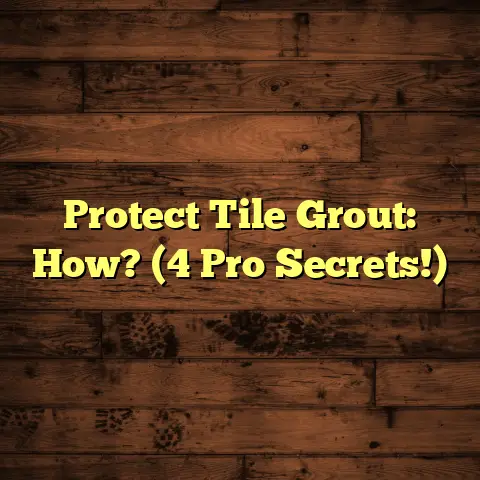Beeswax On Wood Floors: How To Use? (4 Step Fix!)
Have you ever walked into a room with gleaming hardwood floors and wondered how to achieve that same level of beauty in your own home?
I get it.
For years, I’ve seen folks make a
common mistake when it comes to wood floor
care: they reach for harsh chemical cleaners
or heavy oils, thinking that’s the key to
longevity and shine.
But trust me, as a flooring contractor with years of experience under my belt, I can tell you that these solutions often do more harm than good.
They can dull the finish, damage the wood, and lead to long-term wear and tear.
So, what’s the secret?
It’s simple: beeswax.
Yep, that natural stuff bees make.
It’s an incredible, eco-friendly alternative for maintaining and restoring wooden floors.
I’m going to walk you through everything you need to know about using beeswax, from its benefits to a simple, four-step application process that will leave your floors looking amazing.
Section 1: Understanding Beeswax and Its Benefits for Wood Floors
So, what exactly is beeswax?
Well, it’s a natural wax produced by honeybees of the genus Apis.
These amazing insects secrete it from special glands in their abdomen and use it to build honeycomb cells.
It’s a pretty complex substance, composed of various hydrocarbons, fatty acids, esters, and other compounds.
But what really matters is what it can do for your wood floors.
One of the things I love most about beeswax is that it’s completely natural and eco-friendly.
Unlike many commercial floor cleaners, it doesn’t contain any harsh chemicals or synthetic fragrances.
This makes it safe for your home, your family (including kids and pets), and the environment.
And let’s be honest, who wants to be breathing in toxic fumes while trying to clean their floors?
But the benefits don’t stop there.
Beeswax can also dramatically enhance the appearance of your wood floors.
It provides a beautiful, subtle sheen that brings out the natural grain and color of the wood.
It also helps to protect against moisture, preventing water damage and warping.
Plus, beeswax is naturally resistant to dirt and dust, so your floors will stay cleaner for longer.
I remember one client, Sarah, who had inherited a beautiful old home with original hardwood floors.
The floors were dull and scratched, and she wasn’t sure how to restore them without damaging the delicate wood.
I recommended beeswax, and after a weekend of cleaning and applying it, Sarah couldn’t believe the transformation.
The floors were glowing, the scratches were less noticeable, and the whole house felt warmer and more inviting.
She was thrilled, and I was proud to have helped her bring those beautiful floors back to life.
Section 2: Preparing Your Wood Floors for Beeswax Application
Okay, so you’re convinced that beeswax is the way to go.
Great!
But before you start slathering it on your floors, you need to do some prep work.
Trust me, this is a crucial step.
Proper preparation will ensure that the beeswax adheres properly and provides the best possible results.
The two key things you need to do are cleaning and sanding (or buffing).
First, let’s talk about the tools and materials you’ll need:
- Broom and vacuum: For removing loose dirt and debris.
- Mild soap and water: For initial cleaning.
I recommend using a pH-neutral soap to avoid damaging the wood. - Sandpaper or a buffer: For surface preparation.
The grit of sandpaper you’ll need depends on the condition of your floors.
For light scratches, 220-grit sandpaper will do.
For deeper scratches, you may need to start with 120-grit and work your way up to 220-grit. - Beeswax: You can find beeswax in block or liquid form.
I personally prefer the block form, as it tends to be more pure and less processed. - Soft cloths or applicators: For applying the beeswax. Microfiber cloths work great.
Now, let’s get into the step-by-step guide:
Sweep or vacuum the floor: Get rid of any loose dirt, dust, or debris.
Pay special attention to corners and edges.Clean the floor with mild soap and water: Use a damp (not soaking wet) mop or cloth to gently clean the surface.
Make sure to rinse the floor with clean water to remove any soap residue.Let the floor dry completely: This is important!
Beeswax won’t adhere properly to a wet surface.Sand or buff the floor: This step is crucial for removing old finishes and creating a smooth surface for the beeswax to adhere to.
- If your floors have a thick layer of old finish, you’ll need to sand them down using a floor sander.
This is a more involved process, and I recommend hiring a professional if you’re not comfortable doing it yourself. - If your floors have a thin layer of old finish or just some light scratches, you can use a buffer with a fine-grit sanding pad.
This is a gentler option that’s easier to control.
- If your floors have a thick layer of old finish, you’ll need to sand them down using a floor sander.
When sanding or buffing, always work with the grain of the wood.
This will help to prevent scratches and ensure a smooth, even finish.
Once you’ve finished sanding or buffing, vacuum the floor again to remove any sanding dust.
Then, wipe it down with a tack cloth to get rid of any remaining particles.
Your floors should now be clean, dry, and smooth, ready for the beeswax application.
Section 3: The 4-Step Beeswax Application Process
Alright, we’ve reached the exciting part: applying the beeswax!
This is where you’ll really start to see the transformation happen.
I’ve broken down the process into four essential steps to make it as clear and straightforward as possible.
Step 1: Applying the Beeswax
The first step is to actually get the beeswax onto the floor.
You have a couple of options here.
You can use a soft cloth or a wax applicator.
I personally prefer using a soft cloth, as it gives me more control over the application.
If you’re using a block of beeswax, you’ll need to melt it down first.
You can do this in a double boiler or in the microwave.
If you’re using the microwave, be sure to heat it in short intervals (30 seconds at a time) to prevent it from overheating and potentially catching fire.
Once the beeswax is melted, dip your cloth or applicator into it and apply a thin, even layer to the floor.
It’s important to work with the grain of the wood, applying the beeswax in long, smooth strokes.
Don’t apply too much beeswax at once.
A little goes a long way, and you can always add more later if needed.
The goal is to create a thin, even layer that will penetrate the wood and provide protection and shine.
Step 2: Buffing the Surface
After you’ve applied the beeswax, it’s time to buff it into the wood.
This is where you’ll really start to see the magic happen.
Buffing helps to distribute the beeswax evenly and create a smooth, polished finish.
You can buff the floor by hand using a clean, soft cloth, or you can use a floor buffer with a buffing pad.
If you’re buffing by hand, use circular motions and apply moderate pressure.
You’ll want to buff until the beeswax is evenly distributed and the floor has a nice sheen.
If you’re using a floor buffer, start with a low speed and gradually increase it as needed.
Be sure to overlap your passes to ensure that you’re buffing the entire surface evenly.
The key is to find the right balance between pressure and speed.
You want to apply enough pressure to work the beeswax into the wood, but not so much that you damage the finish.
Step 3: Allowing for Curing Time
Once you’ve buffed the floor, it’s time to let the beeswax cure.
Curing is the process of the beeswax hardening and bonding to the wood.
This is a crucial step, as it allows the beeswax to fully protect and enhance the appearance of your floors.
The amount of time it takes for beeswax to cure can vary depending on several factors, including the temperature and humidity in your home.
In general, you should allow the beeswax to cure for at least 24 hours.
However, if the temperature is cool or the humidity is high, you may need to wait longer.
During the curing process, it’s important to avoid walking on the floors or placing any furniture on them.
This will prevent the beeswax from being disturbed and ensure that it cures properly.
Step 4: Final Buffing and Maintenance
After the beeswax has cured, it’s time for the final buffing.
This will help to remove any excess beeswax and create an even more polished finish.
Use a clean, soft cloth or a floor buffer with a buffing pad to gently buff the floor.
You should see a noticeable difference in the sheen and clarity of the finish.
Once you’ve completed the final buffing, your wood floors should be looking their absolute best.
But the work doesn’t stop there.
To keep your floors looking great over time, it’s important to establish a regular maintenance routine.
I recommend re-applying beeswax every 6-12 months, depending on the amount of traffic your floors receive.
You can also use a damp cloth to wipe up any spills or messes as they occur.
Avoid using harsh chemical cleaners, as these can strip the beeswax finish and damage the wood.
With proper care and maintenance, your beeswax- treated wood floors will continue to look beautiful for years to come.
Section 4: Troubleshooting Common Issues
Even with the best preparation and application techniques, you may encounter some challenges when using beeswax on your wood floors.
Here are a few common issues and how to troubleshoot them:
Uneven application: If you notice that some areas of your floor have more beeswax than others, you can try buffing the floor again to redistribute the beeswax evenly.
If that doesn’t work, you may need to re-apply beeswax to the areas that are lacking.Issues with curing: If the beeswax isn’t curing properly, it may be due to high humidity or low temperatures.
Try increasing the temperature in your home and ensuring that the floors are well-ventilated.
You can also try using a dehumidifier to lower the humidity level.Existing finishes reacting poorly with beeswax: In some cases, existing finishes may not be compatible with beeswax.
This can cause the beeswax to become sticky or cloudy.
If this happens, you may need to remove the existing finish before applying beeswax.Floor feels sticky after application: This usually means you’ve applied too much beeswax.
Use a clean cloth and buff vigorously to remove the excess.
You can also try lightly dampening the cloth with mineral spirits to help break down the wax.Dull or uneven shine: This could be due to inadequate buffing.
Go back over the floor with a clean buffing pad or cloth, applying even pressure.
Make sure you’re overlapping your passes to ensure complete coverage.
If you encounter any other issues, don’t hesitate to consult with a flooring professional.
They can provide expert advice and help you troubleshoot any problems that may arise.
Conclusion: The Lasting Beauty of Beeswax on Wood Floors
So, there you have it: a comprehensive guide to using beeswax on your wood floors.
As I’ve shown you, beeswax is a natural, eco- friendly, and effective way to enhance the appearance and protect your wood floors.
It provides a beautiful sheen, protects against moisture, and resists dirt and dust.
And with just a few simple steps, you can restore and maintain your wood floors beautifully and sustainably.
I encourage you to incorporate beeswax into your floor care routine and experience the difference it can make.
Trust me, you won’t be disappointed.
Your wood floors will thank you for it!





